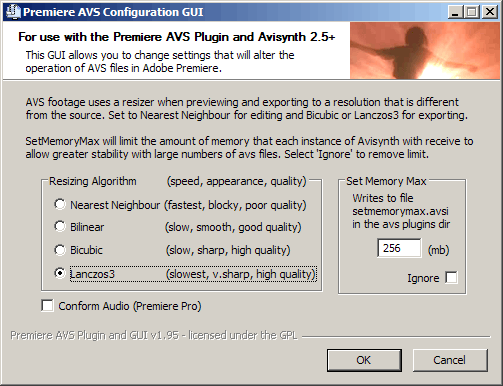AnimeMusicVideos.org > Guide Index
Method 2: Editing DVD footage directly.You have avs files which decode and filter DVD footage all
ready for
editing... but there's a problem. a) Adobe Premiere - Premiere can use .avs files directly thanks to an import plugin which is included in the AMVapp. But, let me make one thing clear. This method is NOT recommended. Making lossless clips is far more stable, and editing will be faster. This method uses lots of ram if you are using several different scripts at once, so coupled with the fact that most video editing software uses lots of ram anyways, this can start to get bogged down very fast. Adobe PremiereTo edit with your avisynth files in Premiere, you will need to download the latest Premiere Import Plugin. If you have downloaded and installed the AMVapp then you should already have it installed. One you have this installed, it will allow you to open AVISynth (.avs) files in Premiere. Note that as of Premiere Pro CS5, this plugin NO LONGER WORKS. Quality, Stability and the Premiere AVS GUI The Premiere plugin, developed by fellow amv-ers, contains
a GUI which can change the quality of the footage you import into
Premiere and it can also set up memory options to make AVS useage more
stable. When Premiere asks for a frame which is a different size than
your source (preview window, timeline or exporting at a different size)
the avs import plugin has to resize it. To do this there are 4
different resizers that you can choose in the GUI:
As you can tell by the descriptions,
low-quality resizers are fast and high quality resizers are slow. So
what I recommend is setting the algorithm to Nearest Neighbour as this
will ensure the timeline thumbnails and monitor previews will be the
fastest they can be. When you export, however, you will want to change
this to one of the other settings as Nearest Neighbour is poor quality.
The slowdown with the better resizers isn't that much though. With a quick 1000 frame rendering test it took 31 seconds with Nearest Neighbour, 34 seconds with bilinear, 36 seconds with Bicubic and 37 seconds with lanczos3. So, if you don't mind that amount of increase then you can keep it high quality all the time. The right hand section of the GUI changes the Set Memory Max preferences in avisynth. Avisynth is not usually designed to process multiple avs scripts at once and as a result the memory can get used up really fast when processing multiple scripts. This can lead to avisynth crashing halfway through a render. To avoid this you can set the maximum memory allowed by each script. This option currently only works with Avisynth 2.5+ (which comes with the amvapp). The default setting is 256mb but if you are using lots of scripts you may want to reduce this to avoid memory crashes. It's a tricky thing to set, however, as some scripts which have a lot of processing may need a lot of memory and could crash if you set it too low - don't go below 32mb unless you really have to. Errors, bugs, limitations and other things to avoid Using avisynth scripts in Premiere can be a delicate matter.
There are a number of things you should be aware of when importing
avs scripts into Premiere:
Now that you've read the info and understand the issues it's
time to see how to correctly set up
your video project. Frameserving Avisynth to Programs without .avs SupportThis method uses what is known as an avi wrapper. Many programs, when you give them a file, expect it to have a header that they recognise just like an avi header or an mpeg header. AVS files, however, are just text files so they do not have the information many programs need. There is a way around this though, using the AviSynth Virtual File System (included in AMVApp). Before you start, you want to make sure all of your avisynth scripts are in RGB32 colorspace, because this is the colorspace that your editing program will probably be expecting. This should be the final line of your avisynth script: ConvertToRGB32() Now, assuming the AviSynth Virtual File System is installed correctly, when you right click on an AviSynth script, you should see two new items in the menu: Quick Mount, and Mount. Choose the quick mount option, and now your AviSynth script should turn into a folder. If you open up this folder then you should see your original avisynth script along with an AVI file. The AVI file will probably report a very large filesize, but this file does not actually take up any space on your disk, because it is a "fake" AVI file. That is, it is simply a virtual file which will allow your editing program to access the AVS script. Now if your AVS script contains any errors, then you wont see an AVI file here--it can't generate anything if your script is incorrect! If that is the case, then you need to right click on this folder and choose "unmount", then correct your avisynth script and try again. Once you are done with that, you can import these fake avi files directly into any program which supports AVIs, and it will think that it is looking at a standard uncompressed AVI file. This method for using Avisynth scripts should work as well as the Premiere method but it has not been tested as thoroughly, so proceed with caution. Like with Premiere there are certain things you need to be careful about when dealing with avisynth footage.
Now you have your fake avi files ready, you can set up your video project. |
